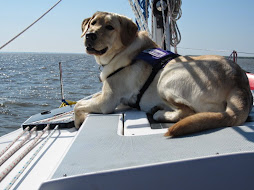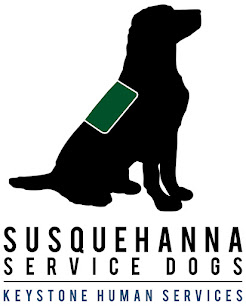Guest post by Samantha Hodge-Williams
I am writing to celebrate Nancy Fierer, a uniquely generous
woman. I will always be grateful to Nancy, who changed my life path
during a critical time.
In 1997, I became suddenly ill in college with a lifelong
chronic, disabling condition. Soon after, whilst trying to support me, my
mother also became disabled. We learned about service dogs and both
applied to a local Baltimore area organization. Unfortunately, not all
service dog schools are created equal, and we found ourselves with two
expensive, untrained dogs from a failed organization.
After working independently with private trainers, I
contacted Nancy in hopes of completing the Susquehanna Service Dogs transfer training and
certification process for each of our dogs. Nancy agreed that we could be
tested and if we performed up to the SSD standard, they would include us in the
transfer training and SSD certification. We both passed.
Before attending SSD graduation, my canine companion and new
“lifeline” suddenly had liver failure and died. Despite my determination,
perseverance and lifelong optimism, I found myself so grief-stricken by this
final loss that I lashed out at loved ones and everything around me. I
had reached my breaking point, feeling so lost and needing to run away.
Nancy invited me to stay with her and Robert for a few
weeks, to research my options for a new successor service dog.
I remember arriving at her house and seeing her flats of
impatiens out front. Nancy said she’d been too busy to plant any, but
would be happy to “employ” me to plant the impatiens in her garden if I liked
during my stay. This small job anchored me through the darkness.
Despite my physical limitations and grief, I could leisurely do this on my
own. Rather than drifting around her home like a grieving guest or
client, I felt I had a purpose. I slowly nestled impatiens in the nooks
and crevices of her trees, enjoying the shady retreat and the dirt between my
fingers. I quietly watched the staff and dogs in training, whilst
watering the buds.
It is now 13 years later. Those few weeks stand out
because I know that in my grief and anger, my life could have taken a very
different fork. However, Nancy’s kind and generous welcome and work nurtured me back toward hope. After staying at LeSentier Lane, I was
able to return home and subsequently be matched with my successor dog.
SSD Aslan now lies beside me, fully retired at 13 ½ after outstanding years of
reliable, joyful service.
Thank you, Nancy, for your generous and warm welcome during
my toughest time. You restored my sense of safety and hope when it
mattered the most. I wish you and Robert all the best in your
well-deserved retirement.
Samantha Hodge-Williams has been partnered with Susquehanna Service Dogs since 2000.








